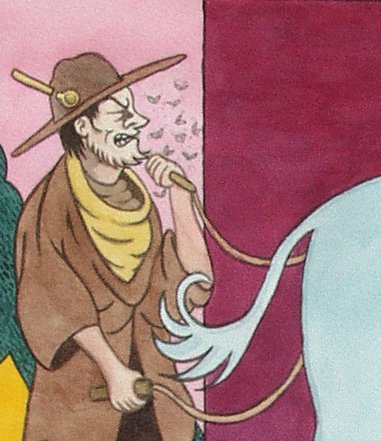Four Stone Hearth 61
 Happy Kuwait Day, Happy People Power Day and, above all, Happy Feast Day of Blessed Maria Adeodata Pisani (who it has to be said really had a truly miserable life).
Happy Kuwait Day, Happy People Power Day and, above all, Happy Feast Day of Blessed Maria Adeodata Pisani (who it has to be said really had a truly miserable life).
But before you get your spirituality on, welcome to the desultory confines of the 61st Four Stone Hearth (4SH) Blog Carnival where, as someone once said, ‘the convivialists habitually exhibit themselves’ (hat tip, cap doff to Pat McCabe and his assorted ragbag of hairy arsed savage good eggmen…).
The last 4SH was at Middle Savagery here. The home page for 4SH is here. And the next 4SH will be at ……well, no-one has stepped up yet – we’ll link to the next host as soon as there is one – addendum: the next 4SH (62) will be here….
We’re delighted to host this session of the carnival. Given that this is the first blog carnival we’ve hosted we were unsure whether to adopt a friendly, conversational style or take a more discursive approach, so instead, principally because the Royal ‘we’ are in the throes of cigarette withdrawal (after twenty wonderful, happy years together, we and the fags had to go our separate ways) and are feeling very impatient, cranky, stroppy and anxious, we decided on just getting it done in whatever way it happens.
Anyway, sit back, pour yourself a generous glass of whiskey and lets raise the curtains on this fortnights best of anthroblogging as submitted or otherwise selected by Moore Group…..
We’ll start with bad news. Throughout the world, the financial crisis appears to be having a worrying impact on the cultural heritage sector with reports from Britain of lay-offs (Britarch reports 345 job losses between Oct 08 and Jan 09 – and see the BBC here), and equally worrying, the dropping of key heritage bills and the devaluing of World Heritage sites across the water. Similarly, here in Ireland our dependence on the construction industry is having a deepening impact on the profession, with anecdotal reports of short-terming, lay-offs and growing redundancies. In Iraq, the re-opening of the National Museum has not exactly been welcomed with gusto by some in the profession (for more see AWBG here), while across the bigger water U. Penn is continuing with layoffs at MASCA (the Museum Applied Science Center for Archaeology) – see the blog and petition here.
But, despite recent events, there has been a huge increase worldwide in our understanding of the past as a result of the last decade’s growth in the Western World and elsewhere. This coming period of turmoil may be the perfect opportunity to engage with the greater public and disseminate all that has been learned, and the new media provide a wonderful resource to do just that. Colleen at Middle Savagery calls for a revolution of sorts ….
‘Roll up your sleeves’, she demands…
“With archaeology employment declining and the world economy burning down around us it is more important than ever to do everything we can to bring archaeology to the public. Our organization policy makers in the Society for American Archaeology in the States and more broadly in the World Archaeological Congress work hard and do what they can to raise awareness of the preservation of archaeological sites and the promotion of archaeological education, but they are not enough.
So my question is one inspired by the Young Lions Conspiracy: What are you doing to Participate?”
Speaking of participation – We still seem to be waiting on When on Google Earth #5, derived from a geologists game and introduced to the anthroblogosphere by Shawn Graham at Electric Archaeologist. This is/was great fun. The winner posts a picture from Google Earth and poses the question ‘Where is the site and what was the main period of occupation?’ The last one we could find was won by Jason over at AWBG. If we’ve missed the next one maybe someone could point to it in the comments.
CORRECTION: Whenonge #5 is up at AWBG, and it’s already been correctly answered. Damn quick work.

Neuroanthropology points out another disturbing side-affect of the downturn – the crisis in Science News. News agencies downsizing/rightsizing/consolidating and cutting budgets and column inches dedicated to science reporting, with the resultant growing journalist amateurism providing more informed readers with a little entertainment, but, more seriously, that ‘these budgetary constraints will provide yet another force pushing for reductionary explanations in the public eye.’
I might add that, since we began blogging here at Moore Group, I’ve emigrated my science reading to the intertubes, and particularly science bloggers (the genre, not necessarily the site). Maybe NA’a observations are indicative of a general migration to science news gathering via the web. Often, what’s remarkable news to anthropologists and archaeologists just seems a little dull to the general reader and the internet provides a place to target that readership a little better. Maybe it’s the job of anthrobloggers today to take up the slack and make Science news, as the conventional media withdraw from specialist reporting.
On the other hand, there are responsibilities which come with that very role and Pharyngula recently drew attention to the announcement of the near completion of the Neanderthal genome and the problem of science by press release. While conceding that the news might be very exciting, he bemoaned the fact that there was ‘too much PR and too little information’.
Meanwhile John Hawks answers a few questions about the announcement and makes the point that:
“One year from now, there will be high school students working with sequences from the Neandertal genome. Who knows what they will discover? I just think that is tremendously exciting. For the first time, the primary data of paleoanthropology will be available to everyone.”
Anna Barros’ (annasbones) debut at the Nature Network is a humdinger, with a provocative post on Neanderthal hybrids, one of her favourite topics!
“I’ve been reading about the genetics side of things lately, since it’s all the rage these days, but being a ‘bone lady’ myself, I’d like to introduce you to some ideas about why I believe Zilhao and Trinkaus (2002, 2003, 2008) have it all wrong.”
It’s thought that here in Galway, our modern docks (where we will be hosting the Volvo Ocean Race soon) and areas of reclamation throughout the city were partially constructed using some of the Medieval City wall. Martin at Aardvarchaeology discusses ‘the past in the past’ and how people engaged with archaeological remains in their own era. It’s a fascinating topic and one often finds that our ancestors may have had less interest in the remnants of their predecessors than one might expect. As a local example, during excavation of a souterrain on the route of the controversial M3 (Tara) motorway, one of the capstones was found to have been recycled from an even earlier site and:
“had decoration carved into the side of the stone. The art consists mainly of a double row of zigzags or chevrons, half a series of concentric circles and what appears to be a nest of arcs. Preliminary interpretation suggests that originally the stone was used as a kerbstone in a Neolithic passage tomb. It was split before incorporation into the souterrain and the decoration would not have been visible inside the chamber.”
 Martin applauds whoever put aside old headstones from a graveyard in Gothenburg and tells us ‘But get this: people are upset that the stones haven’t been given the usual treatment in modern Sweden, which is to be taken away and crushed into gravel!’.
Martin applauds whoever put aside old headstones from a graveyard in Gothenburg and tells us ‘But get this: people are upset that the stones haven’t been given the usual treatment in modern Sweden, which is to be taken away and crushed into gravel!’.
At Testimony of the Spade, Magnus summarises the Swedish Osteological Association’s annual workshop which was held recently in cooperation with the Osteoarchaeological Research Laboratory (OFL) in Stockholm University. Our osteologist Camilla is currently based at the lab there and we send our fond greetings to Sweden and demand that you don’t forget to bring us back some reindeer jerky next time.
Linguistic Anthropology recently…
“had two experiences in which people — college-aged individuals on or near a college campus — used routine speech formulas in surprising ways.
The first was relatively easy to explain. As I left my office, I smiled at a young woman who was sitting just outside the door and said, “Hello.”
CDN: Hello.
Woman: Good, how are you doing?
This exchange resembles what Sacks, Schegloff & Jefferson (1974:716) call a greeting-greeting adjacency pair.”
It reminded us of an unusual greeting used principally in Derry which I’ve heard on only a few occasions:
“Greeting Person 1: Yes?
Greeting Person 2: Yes!”
Busy people, those Derry folk (as GW would say), no time for the ‘Are you well?’ bit….
And allegedly in Dungiven, a common greeting comprises:
“How’s about ye, Are you well, How you doin’, how’s things, how are ye?”
And in a similar vein, in Ballymena, a common greeting is ‘Bycha?’ (what about you)…..
Mark at Ideophone describes a Mawu funeral dirge and notes how:
“Two factors are contributing to their decline: firstly the fact that many churches discourage their use, preferring edifying hymns instead. The reason behind this, I am told, is that the dirges reflect a pre-Christian worldview and as such are to be eschewed by true Christians.”
Similarly to the now-extinct Irish (and Scottish) tradition of keening (from the Irish caoineadh – to cry), which died out as a result of opposition from the Catholic Church, the Mawu dirge emphasises the condition of those left behind…
As Ideophone says:
“We may think we’re lucky to have company, but in the end it turns out to be mourning, tears, sadness, graves.”
Mark also directed us to the AAA Photo Contest at Flickr, in which one of his submissions was featured.
Again, on language, Transient languages and cultures presents a critique of UNESCO’s latest version of its Atlas of the World’s Languages in Danger edited by Christopher Moseley.
 I can’t say I understand much of the Basketball stuff in Daniel’s post on ‘Measuring Process Not Belief: Shane Battier and Stress’ at Neuroanthropology, but I guess the idea can be applied to any team sport. With a lovely turn of phrase Daniel describes how we need a ‘Shane Battier of stress’:
I can’t say I understand much of the Basketball stuff in Daniel’s post on ‘Measuring Process Not Belief: Shane Battier and Stress’ at Neuroanthropology, but I guess the idea can be applied to any team sport. With a lovely turn of phrase Daniel describes how we need a ‘Shane Battier of stress’:
“How would he or she play the game? Like Shane Battier, mixing some ethnographic street ball with some polished lab play, or more broadly moving between different worlds of academic success and meshing them together into something unique.”
And finally for today, we’re big fans of post-holes at Moore Group and Geoff Carter’s blog ‘Theoretical Structural Archaeology’ hits all the marks for us. He’s at part 23 – Prehistoric Building Regulations currently, so there’s a lot of great stuff to catch up on if you haven’t already discovered TSA..
From his about page:
“I am a professional archaeologist who has spent 20 years trying to gain an understanding of timber building and architecture in the Prehistoric Britain, and this blog is the only way I have to disseminate the things I have found out and the methodology I use.
Its a vast subject, so in this blog I intend to try and concentrate on timber buildings and structures from a selection of sites in the southern half of England from the period 2000BC -500AD.”
So that’s it for this 4SH, we hope you get as much enjoyment out of the posts we’ve referenced as we did., and that we did’nt leave anyone out. Certainly the over-riding theme of the last two weeks seems to be that as science and anthro bloggers, perhaps our greatest task is to continue to tell the story and spread it….
I thinks Colleen says it best from her post referenced above:
“We must interfere in the public’s understanding in the past. Change it. Surprise, enlighten, destroy when necessary and rebuild a better, stronger, more curious and more passionate interest in what we do. This is my charge to myself and to other archaeologists and to anyone who wants to join us.
What are you doing to Participate?”
 Now, having done our duty, a portion of Moore Group are off to the UK to attend a day school in Oxford on the archaeology of the Great War, and afterwards to watch the Irish-English rugby match in the cold heart of the Empire. This is our second encounter with the ancient enemy in the fine stadium of Croke Park (location of the first Bloody Sunday). So, in the interests of diplomacy and good international relations, as we close the velvet curtain on the 61st 4SH, I won’t translate the following joke (HT Southie Sham). The non-Irish among you can guess the meaning.
Now, having done our duty, a portion of Moore Group are off to the UK to attend a day school in Oxford on the archaeology of the Great War, and afterwards to watch the Irish-English rugby match in the cold heart of the Empire. This is our second encounter with the ancient enemy in the fine stadium of Croke Park (location of the first Bloody Sunday). So, in the interests of diplomacy and good international relations, as we close the velvet curtain on the 61st 4SH, I won’t translate the following joke (HT Southie Sham). The non-Irish among you can guess the meaning.
“A farmer in Rosmuc was walking through his fields and came upon a man drinking water from a pool with his hand.
The farmer shouts “Na ól an t-uisce, tá se lán le chac bó!”
The man shouts back: “I’m English! Speak English Paddy, I don’t understand you”.
The farmer responds, “Use both hands; you’ll get more in!”
Footnote: We’ve illustrated this edition of the 4SH with some details from a series of paintings we commissioned back in the days of the ‘Celtic Tiger’ when everyone had money to burn on useless frivolities such as Art, or more worthwhile investments like property, land and politicians (see side panel ‘About our Header’ for more details about the ‘Bestiary’, and view the complete collection by clicking the links on our website here).
This entry was posted on Wednesday, February 25th, 2009 at 5:52 pm. It is filed under About Archaeology and tagged with anthropology, archaeology, Blog Carnival, four stone hearth, Linguistic Anthropology, Physical Anthropology.
You can follow any responses to this entry through the RSS 2.0 feed.

 Happy Kuwait Day,
Happy Kuwait Day, 
 Martin applauds whoever put aside old headstones from a graveyard in Gothenburg and tells us ‘But get this: people are upset that the stones haven’t been given the usual treatment in modern Sweden, which is to be taken away and crushed into gravel!’.
Martin applauds whoever put aside old headstones from a graveyard in Gothenburg and tells us ‘But get this: people are upset that the stones haven’t been given the usual treatment in modern Sweden, which is to be taken away and crushed into gravel!’. I can’t say I understand much of the Basketball stuff in Daniel’s post on
I can’t say I understand much of the Basketball stuff in Daniel’s post on  Now, having done our duty, a portion of Moore Group are off to the UK to attend a day school in Oxford on the archaeology of the Great War, and afterwards to watch the Irish-English rugby match in the cold heart of the Empire. This is our second encounter with the ancient enemy in the fine stadium of Croke Park (location of the first Bloody Sunday). So, in the interests of diplomacy and good international relations, as we close the velvet curtain on the 61st 4SH, I won’t translate the following joke (HT Southie Sham). The non-Irish among you can guess the meaning.
Now, having done our duty, a portion of Moore Group are off to the UK to attend a day school in Oxford on the archaeology of the Great War, and afterwards to watch the Irish-English rugby match in the cold heart of the Empire. This is our second encounter with the ancient enemy in the fine stadium of Croke Park (location of the first Bloody Sunday). So, in the interests of diplomacy and good international relations, as we close the velvet curtain on the 61st 4SH, I won’t translate the following joke (HT Southie Sham). The non-Irish among you can guess the meaning.

[…] Comments Jada on Demons on the WebFour Stone Hearth 61… on Measuring Process Not Belief: …Four Stone Hearth 61… on […]
Thanks for the plug
For you, an Irish posthole thought for the day;
If you found Nevan Fort in Wessex – would it be called a ‘Neolithic Timber circle’ ?
Whenonge #7 is up in the meantime:
http://geevor.wordpress.com/2009/03/02/when-on-google-earth-no-7/